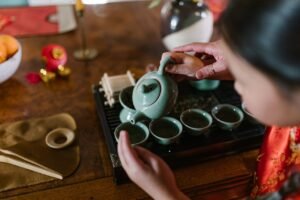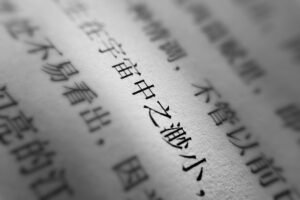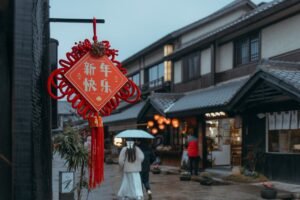Chinese ink painting, known as “shuǐ mò huà” (水墨画), is a distinctive and profound art form that has been practiced for centuries. It embodies the spirit, philosophy, and aesthetics of traditional Chinese culture. This comprehensive guide explores the techniques, materials, and vocabulary associated with Chinese ink painting, providing a deep understanding of this artistic practice.
Table of Contents
ToggleHistorical Background
Origins and Evolution
Ancient Beginnings: Chinese ink painting has its roots in the Tang Dynasty (618-907 AD), though its techniques were developed and refined during the subsequent Song (960-1279 AD) and Yuan (1271-1368 AD) dynasties. Early ink paintings were often created by scholars and poets who used the medium to express their thoughts and emotions.
Literati Painting: During the Song Dynasty, the literati, or scholar-artists, began to dominate the field of ink painting. They emphasized personal expression and the philosophical aspects of art, valuing spontaneity and the conveying of inner feelings over realistic representation.
Ming and Qing Dynasties: The Ming (1368-1644) and Qing (1644-1912) dynasties saw further evolution of ink painting techniques. Artists experimented with new styles and subjects, while traditional themes and methods continued to flourish.
Essential Materials
Brushes (毛笔, máo bǐ)
Types of Brushes: Chinese ink painting brushes are categorized based on their shape and the type of hair used. The three main types are:
- Yang Hao (羊毫, yáng háo): Made from goat hair, these brushes are soft and absorbent, ideal for sweeping strokes and washes.
- Lang Hao (狼毫, láng háo): Made from wolf hair, these brushes are firm and resilient, suitable for detailed work and fine lines.
- Jian Hao (兼毫, jiān háo): A combination of goat and wolf hair, these brushes offer versatility, allowing for both broad strokes and fine details.
Brush Care: Proper care of brushes is crucial. After each use, brushes should be rinsed thoroughly with clean water, reshaped, and hung to dry with the bristles facing down to maintain their shape and longevity.
Ink (墨, mò)
Types of Ink: Traditional Chinese ink is made from soot and animal glue, forming ink sticks that are ground on an ink stone with water to produce liquid ink. The quality of the ink depends on the fineness of the soot and the adhesive properties of the glue.
Ink Stone (砚台, yàn tái): The ink stone is an essential tool for grinding ink sticks. It is typically made from stone, although other materials like ceramic or bronze can also be used. The stone must have a smooth surface to produce a fine, even ink.
Paper (纸, zhǐ) and Silk (绢, juàn)
Xuan Paper (宣纸, xuān zhǐ): Xuan paper, also known as rice paper, is the most common paper used in Chinese ink painting. It is prized for its ability to absorb ink and water, allowing for a wide range of expressive brushstrokes. There are different types of Xuan paper, including raw (生宣, shēng xuān) and processed (熟宣, shú xuān), each offering unique characteristics.
Silk (绢, juàn): Silk is another traditional surface for Chinese ink painting. Paintings on silk often require a different technique due to its smooth texture and less absorbent nature compared to Xuan paper.
Mounting (装裱, zhuāng biǎo)
Mounting Process: Mounting is an essential step to preserve and present Chinese ink paintings. It involves attaching the artwork to a backing paper and often framing it with decorative borders. This process not only enhances the visual appeal but also protects the painting from damage.
Techniques and Styles
Basic Techniques
Mo Fa (墨法, mò fǎ) – Ink Techniques:
- Dry Brush (干笔, gān bǐ): Producing sharp, textured lines by using a relatively dry brush.
- Wet Brush (湿笔, shī bǐ): Creating soft, flowing lines with a wet brush loaded with ink.
- Layering (叠墨, dié mò): Building up layers of ink to achieve depth and intensity.
Bi Fa (笔法, bǐ fǎ) – Brush Techniques:
- Outline (勾勒, gōu lè): Using fine lines to outline shapes and forms.
- Shading (皴法, cūn fǎ): Techniques such as “cun” (皴), which involves different methods of shading to create texture and volume.
- Stippling (点染, diǎn rǎn): Using dots to add texture and detail.
Common Subjects
Landscapes (山水画, shān shuǐ huà): Landscape painting, or “shan shui hua,” is a major genre in Chinese ink painting. Artists depict mountains, rivers, and natural scenes, often infused with a sense of harmony and balance. Key elements include:
- Mountains (山, shān): Representing stability and endurance.
- Water (水, shuǐ): Symbolizing fluidity and life.
- Trees and Plants (树木, shù mù): Conveying growth and vitality.
Figures (人物画, rén wù huà): Figure painting focuses on human subjects, capturing their expressions, postures, and the context of their activities. This genre often includes historical figures, deities, and everyday people.
Floral and Birds (花鸟画, huā niǎo huà): Floral and bird paintings celebrate the beauty of nature, featuring flowers, birds, insects, and other elements. Each subject holds symbolic meanings, such as:
- Plum Blossom (梅, méi): Resilience and purity.
- Orchid (兰, lán): Elegance and modesty.
- Bamboo (竹, zhú): Flexibility and strength.
- Chrysanthemum (菊, jú): Longevity and endurance.
Composition Principles
Balance (平衡, píng héng): Balance is crucial in Chinese ink painting. Artists strive to achieve a harmonious composition where elements are arranged thoughtfully, creating a sense of stability.
Empty Space (留白, liú bái): Empty space, or “liu bai,” is an important aspect of Chinese painting. It provides a visual breathing space and enhances the overall composition by highlighting the painted elements.
Perspective (透视, tòu shì): Unlike Western linear perspective, Chinese ink painting often employs a multiple perspective approach, allowing viewers to experience the scene from various viewpoints.
Advanced Techniques
Boneless Style (没骨法, méi gǔ fǎ): In this style, artists paint directly with color or ink without using outlines. It requires precise control and understanding of brush and ink to convey form and volume.
Splashing Ink (泼墨法, pō mò fǎ): A dynamic technique where ink is splashed or dripped onto the paper, creating spontaneous and expressive effects. This method often reflects the artist’s emotional state and spontaneity.
Essential Vocabulary
Understanding key Chinese ink painting terms can significantly enhance your comprehension and appreciation of this art form. Here’s a list of useful terms:
- 水墨画 (shuǐ mò huà) – Ink painting
- 毛笔 (máo bǐ) – Brush
- 墨 (mò) – Ink
- 砚台 (yàn tái) – Ink stone
- 宣纸 (xuān zhǐ) – Xuan paper
- 绢 (juàn) – Silk
- 装裱 (zhuāng biǎo) – Mounting
- 干笔 (gān bǐ) – Dry brush
- 湿笔 (shī bǐ) – Wet brush
- 勾勒 (gōu lè) – Outline
- 皴法 (cūn fǎ) – Shading technique
- 点染 (diǎn rǎn) – Stippling
- 山水画 (shān shuǐ huà) – Landscape painting
- 人物画 (rén wù huà) – Figure painting
- 花鸟画 (huā niǎo huà) – Floral and bird painting
- 梅 (méi) – Plum blossom
- 兰 (lán) – Orchid
- 竹 (zhú) – Bamboo
- 菊 (jú) – Chrysanthemum
- 平衡 (píng héng) – Balance
- 留白 (liú bái) – Empty space
- 透视 (tòu shì) – Perspective
- 没骨法 (méi gǔ fǎ) – Boneless style
- 泼墨法 (pō mò fǎ) – Splashing ink
Mastering Chinese Ink Painting
Learning from Masters
Study Classic Works: Studying the works of renowned Chinese ink painters, such as Wang Wei (王维, Wáng Wéi) from the Tang Dynasty, and Zhang Daqian (张大千, Zhāng Dàqiān) from the modern era, can provide invaluable insights into techniques and styles.
Understand Philosophical Concepts: Chinese ink painting is deeply intertwined with Daoist and Confucian philosophies. Concepts like “qi” (气, qì) – the life force, and “dao” (道, dào) – the way or path, are fundamental to understanding the essence of the art form.
Practice and Techniques
Daily Practice: Regular practice is essential. Begin with basic brushstrokes and gradually move on to more complex compositions. Practicing calligraphy (书法, shū fǎ) can also enhance brush control and understanding of strokes.
Experiment with Techniques: Experiment with different techniques and styles. Try combining dry and wet brush techniques, layering ink, and using stippling to add texture. Experimentation helps in discovering personal style and expression.
Mindful Painting: Chinese ink painting is often a meditative practice. Approach painting with a calm mind, focusing on the flow of the brush and the interaction of ink and paper. This mindfulness enhances creativity and expression.
Advanced Topics
Color in Ink Painting
Use of Color: While traditional ink painting primarily uses black ink, colors can be introduced to enhance compositions. Mineral pigments and vegetable dyes are commonly used. Colors should be applied sparingly to maintain harmony and balance.
Symbolism of Colors: Colors in Chinese painting often carry symbolic meanings. For example:
- Red (红, hóng): Happiness and good fortune.
- Yellow (黄, huáng): Earth and royalty.
- Blue (蓝, lán): Immortality and heaven.
- Green (绿, lǜ): Spring and growth.
The Role of Poetry and Calligraphy
Integration of Arts: Chinese ink painting often integrates poetry and calligraphy. Poems written in beautiful calligraphy are included in the painting, enhancing the thematic depth and artistic value. The choice of words and the style of calligraphy add another layer of meaning to the artwork.
Learning Calligraphy: Mastering calligraphy is an essential skill for ink painters. The principles of stroke order, balance, and rhythm in calligraphy translate directly to brushwork in painting.
Contemporary Ink Painting
Modern Influences: Contemporary Chinese ink painters blend traditional techniques with modern themes and styles. Artists like Xu Bing (徐冰, Xú Bīng) and Cai Guo-Qiang (蔡国强, Cài Guóqiáng) explore new dimensions of ink painting, integrating multimedia and performance art.
Global Impact: Chinese ink painting has influenced and been influenced by global art movements. Its principles and aesthetics resonate with abstract expressionism, minimalism, and other modern art forms.
Conclusion
Chinese ink painting is a rich and multifaceted art form that combines technical skill, philosophical depth, and personal expression. Understanding the materials, techniques, and vocabulary associated with this tradition can deepen your appreciation and mastery of the art. Whether studying classic works, practicing brush techniques, or exploring contemporary styles, the journey into Chinese ink painting is a rewarding and enlightening experience.
Comprehensive Vocabulary List
| English | Chinese (Pinyin) |
|---|---|
| Ink painting | 水墨画 (shuǐ mò huà) |
| Brush | 毛笔 (máo bǐ) |
| Ink | 墨 (mò) |
| Ink stone | 砚台 (yàn tái) |
| Xuan paper | 宣纸 (xuān zhǐ) |
| Silk | 绢 (juàn) |
| Mounting | 装裱 (zhuāng biǎo) |
| Dry brush | 干笔 (gān bǐ) |
| Wet brush | 湿笔 (shī bǐ) |
| Outline | 勾勒 (gōu lè) |
| Shading technique | 皴法 (cūn fǎ) |
| Stippling | 点染 (diǎn rǎn) |
| Landscape painting | 山水画 (shān shuǐ huà) |
| Figure painting | 人物画 (rén wù huà) |
| Floral and bird painting | 花鸟画 (huā niǎo huà) |
| Plum blossom | 梅 (méi) |
| Orchid | 兰 (lán) |
| Bamboo | 竹 (zhú) |
| Chrysanthemum | 菊 (jú) |
| Balance | 平衡 (píng héng) |
| Empty space | 留白 (liú bái) |
| Perspective | 透视 (tòu shì) |
| Boneless style | 没骨法 (méi gǔ fǎ) |
| Splashing ink | 泼墨法 (pō mò fǎ) |
| Life force | 气 (qì) |
| The way or path | 道 (dào) |
| Calligraphy | 书法 (shū fǎ) |
| Red | 红 (hóng) |
| Yellow | 黄 (huáng) |
| Blue | 蓝 (lán) |
| Green | 绿 (lǜ) |
| Happiness | 喜 (xǐ) |
| Good fortune | 福 (fú) |
| Earth | 地 (dì) |
| Royalty | 王 (wáng) |
| Immortality | 永 (yǒng) |
| Heaven | 天 (tiān) |
| Spring | 春 (chūn) |
| Growth | 长 (zhǎng) |
By familiarizing yourself with these terms and understanding the principles and techniques of Chinese ink painting, you’ll be well-equipped to explore this timeless art form.








